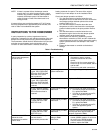
D896 AUTOMATIC VENT DAMPER
68-0186
10
ANSI STANDARDS
EXHIBIT A
Procedure For Safety Inspection of an Existing Appliance Installation
The following procedure is intended as a guide to aid in
determining that an appliance is properly installed and is in a
safe condition for continuing use.
This procedure is predicated on central furnace, boiler and
water heater installations, and it should be recognized that
generalized procedures cannot anticipate all situations.
Accordingly, in some cases deviation from this procedure may
be necessary to determine safe operation of the equipment:
a. This procedure shall be performed prior to installation
of the automatic vent damper device.
b. If it is determined there is a condition which could result
in unsafe operation, the appliance should be shut off
and the owner advised of the unsafe condition. Do not
install the automatic vent damper device until the
unsafe condition has been corrected.
The following steps are to be followed in making the safety
inspection:
1. Conduct a gas leakage test of the appliance piping and
control system downstream of the shutoff valve in the
supply line to the appliance.
2. Visually inspect the venting system for proper size,
horizontal pitch and vent termination, and determine
there is no blockage or restriction, leakage, corrosion
and other deficiencies which could cause an unsafe
condition.
3. Determine that the chimney or vent is acceptable to the
authority having jurisdiction.
4. Shut off all gas to the appliance and shut off any other
fuel-gas burning appliance within the same room.
Use
the shutoff valve in the supply line to each appliance.
5. Inspect burners and crossovers for blockage and
corrosion.
6.
Applicable only to furnaces
—inspect heat exchanger for
cracks, openings or excessive corrosion.
7.
Applicable only to boilers
—inspect for evidence of water
or combustion product leaks.
8. Insofar as is practical, close all building doors and
windows and all doors between the space in which the
appliance is located and other spaces of the building.
Turn on clothes dryers. Turn on any exhaust fans, such
as range hoods and bathroom exhausts, so they will
operate at maximum speed. Do not operate a summer
exhaust fan. Close fireplace dampers. If, after
completing Steps 9 through 14, it is believed sufficient
combustion air is not available, refer to local codes, or
in the absence of local codes, to the National Fuel Gas
Code, ANSI Z223.1-1988 (NFPA 54), for guidance.
9. Place in operation the appliance being inspected.
Follow the lighting instructions.
Adjust thermostat so
appliance will operate continuously.
10. Determine that the pilot(s), when provided, is burning
properly and that main burner ignition is satisfactory by
interrupting and reestablishing the electrical supply to
the appliance in any convenient manner.
If the appliance is equipped with a continuous pilot(s), test the
pilot safety device(s) to determine if it is operating properly by
extinguishing the pilot(s) when the main burner(s) is off and
determining, after 3 minutes, that the main burner gas does
not flow upon a call for heat.
If the appliance is not provided with a pilot(s), test for proper
operation of the ignition system in accordance with the
appliance manufacturer’s lighting and operating instructions.
11. (a) Visually determine that main burner gas is burning
properly; i.e., no floating, lifting or flashback. Adjust
the primary air shutter(s) as required.
(b) If the appliance is equipped with high and low
flame controlling or flame modulation, check for
proper main burner operation at low flame.
12. Test for spillage at the draft hood relief opening after 5
minutes of main burner operation. Use the flame of a
match or candle, or smoke from a cigarette, cigar or
pipe.
13. Turn on all other fuel-burning appliances within the
same room so they will operate at their full inputs.
Follow lighting instructions for each appliance.
14. Repeat Steps 11 and 12 on the appliance being
inspected.
15. Return doors, windows, exhaust fans, fireplace
dampers and any other fuel-gas burning appliances to
their previous conditions of use.
16.
Applicable only to furnaces
—Check both the limit
control and the fan control for proper operation. Limit
control operation can be checked by blocking the
circulating air inlet or temporarily disconnecting the
electrical supply to the blower motor and determining
that the limit control acts to shut off the main burner
gas.
17.
Applicable only to boilers
—
(a) Determine that the water pumps are in operating
condition.
(b) Test low water cutoffs, automatic feed controls,
pressure and temperature limit controls, and relief
valves in accordance with the manufacturer’s
recommendations to determine they are in
operating condition.
Exhibit A of ANSI Standard Z21.66-1994 for Electrically Operated Automatic Vent Damper Devices
for use with Gas-Fired Appliances.














